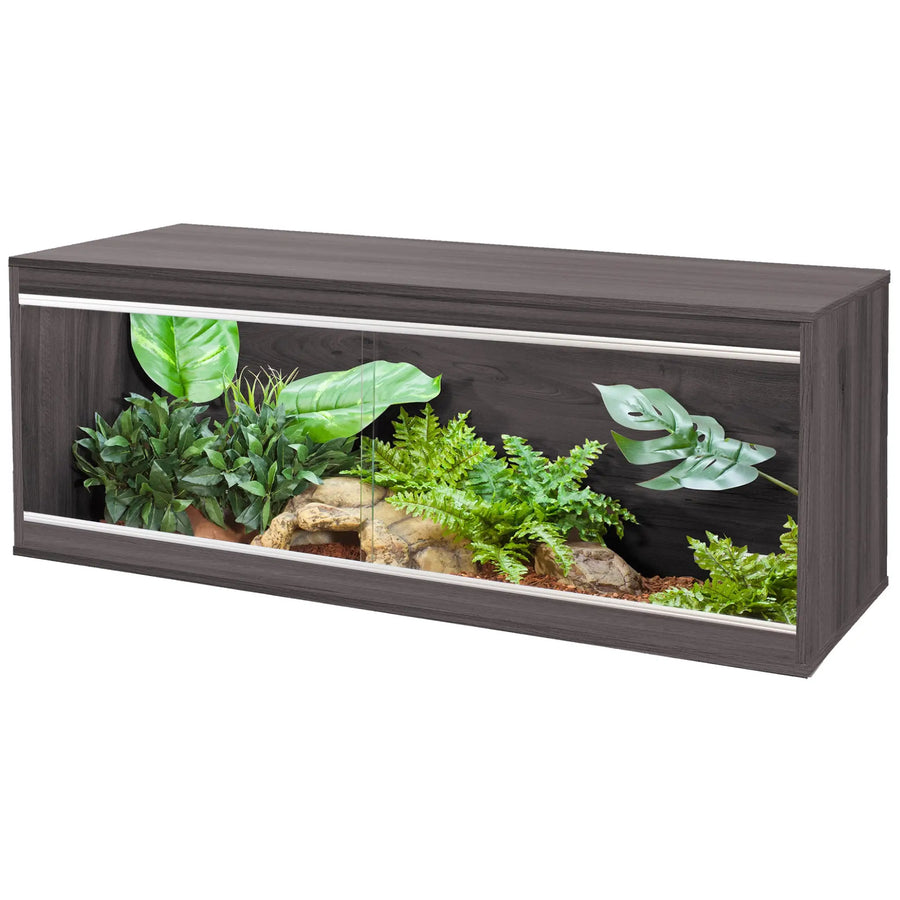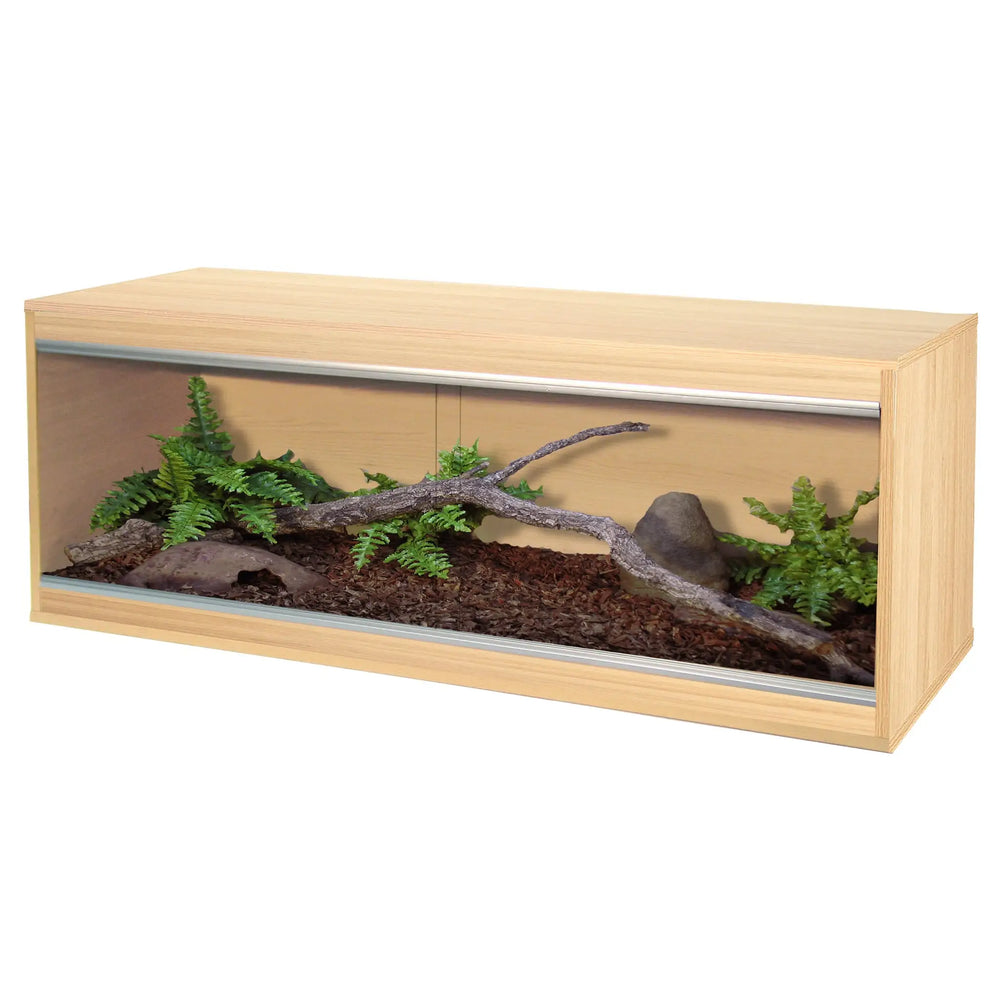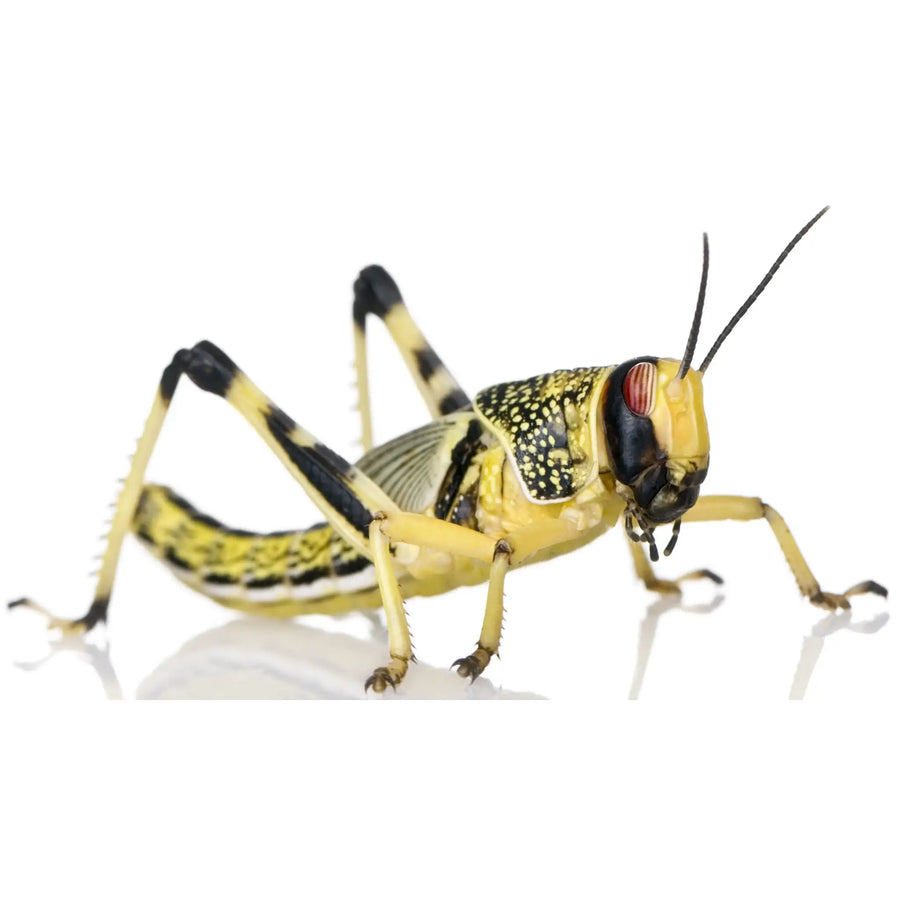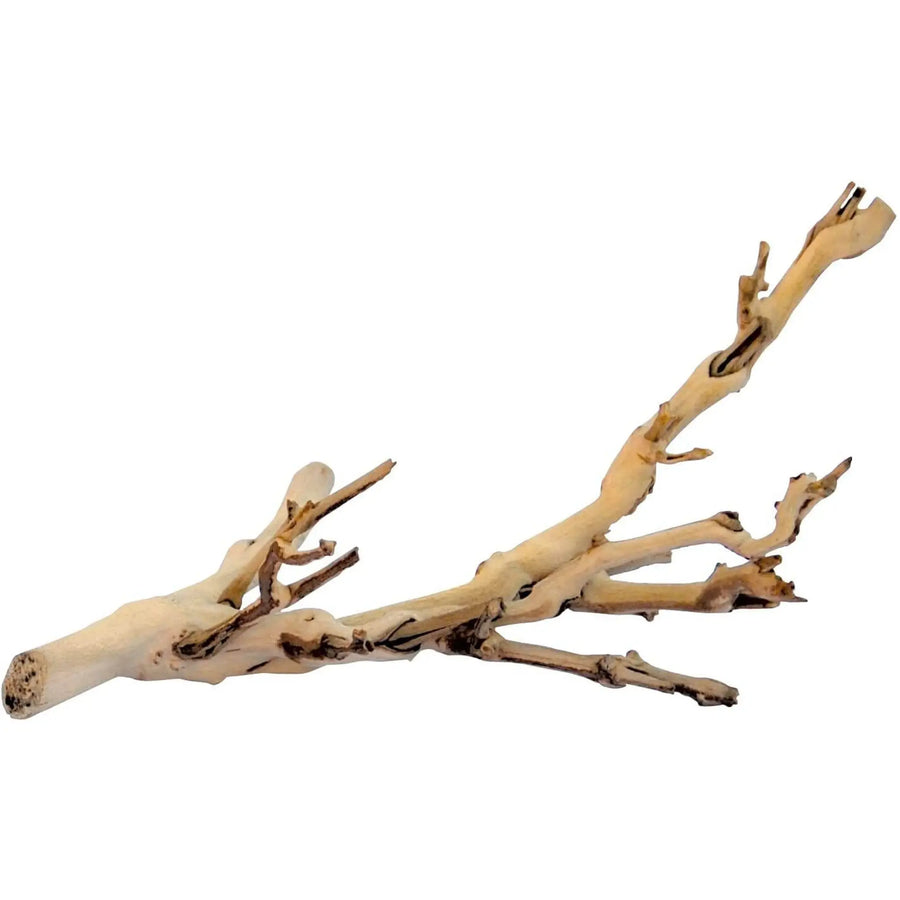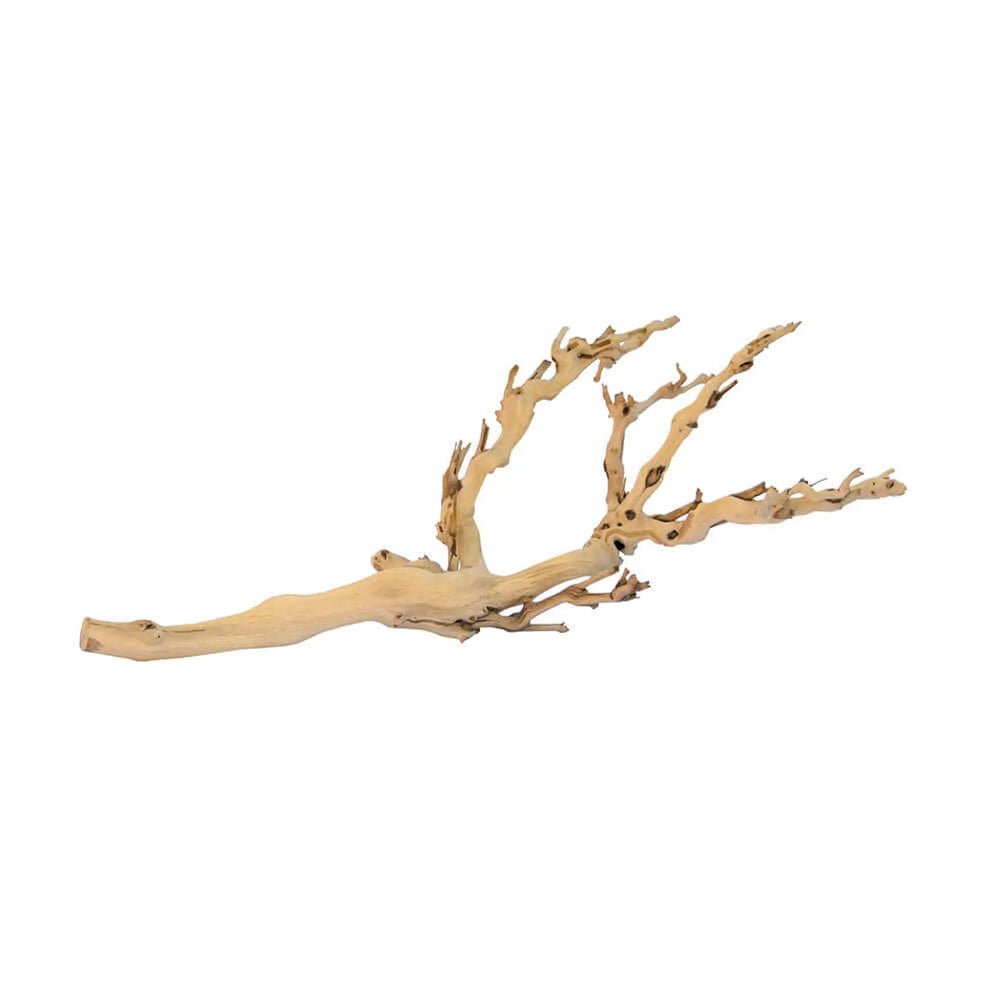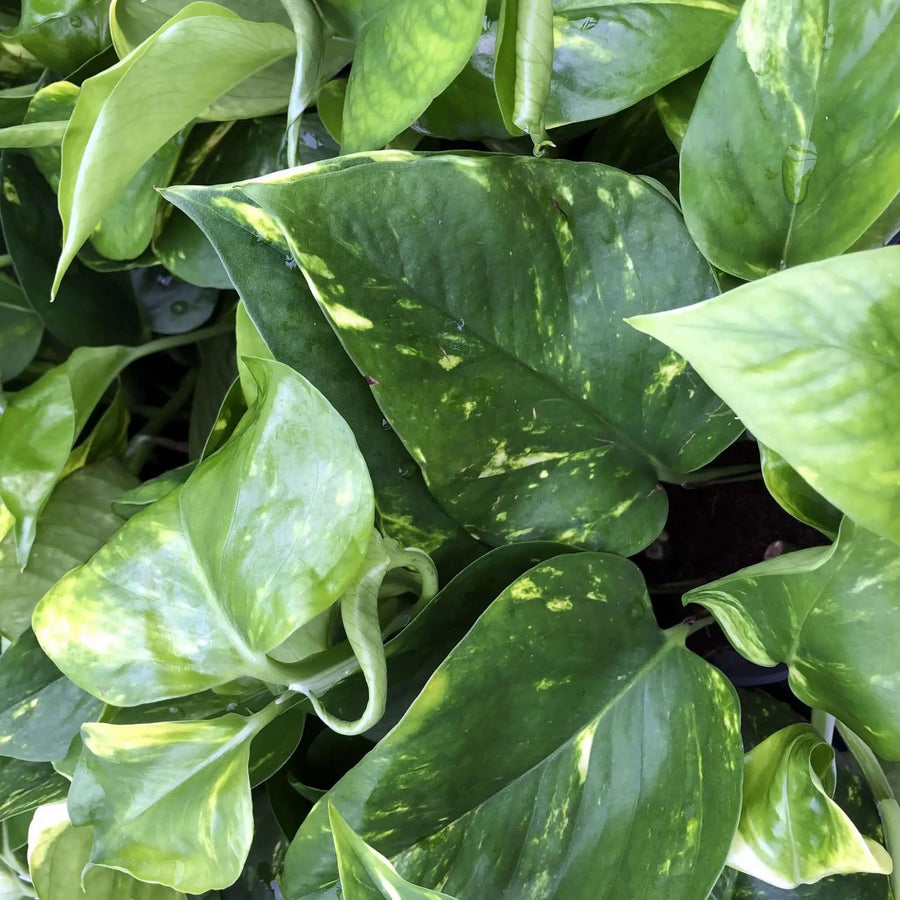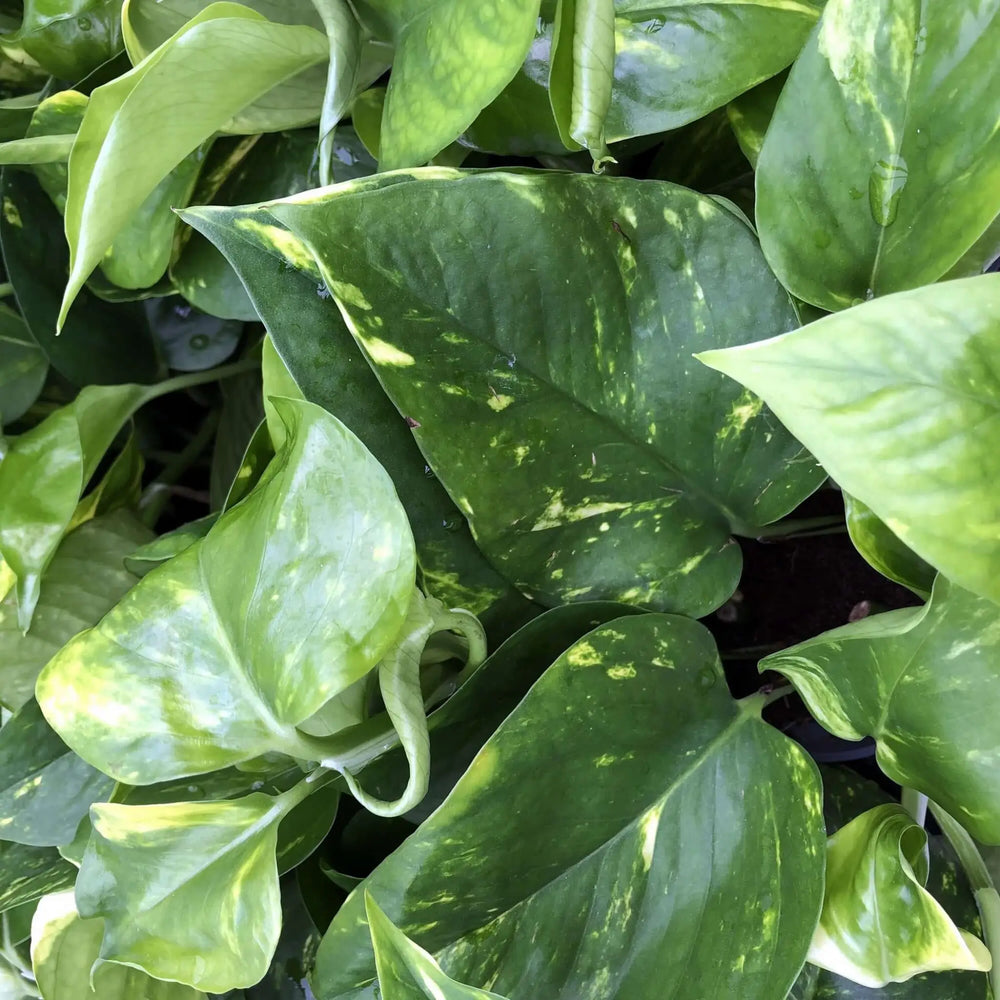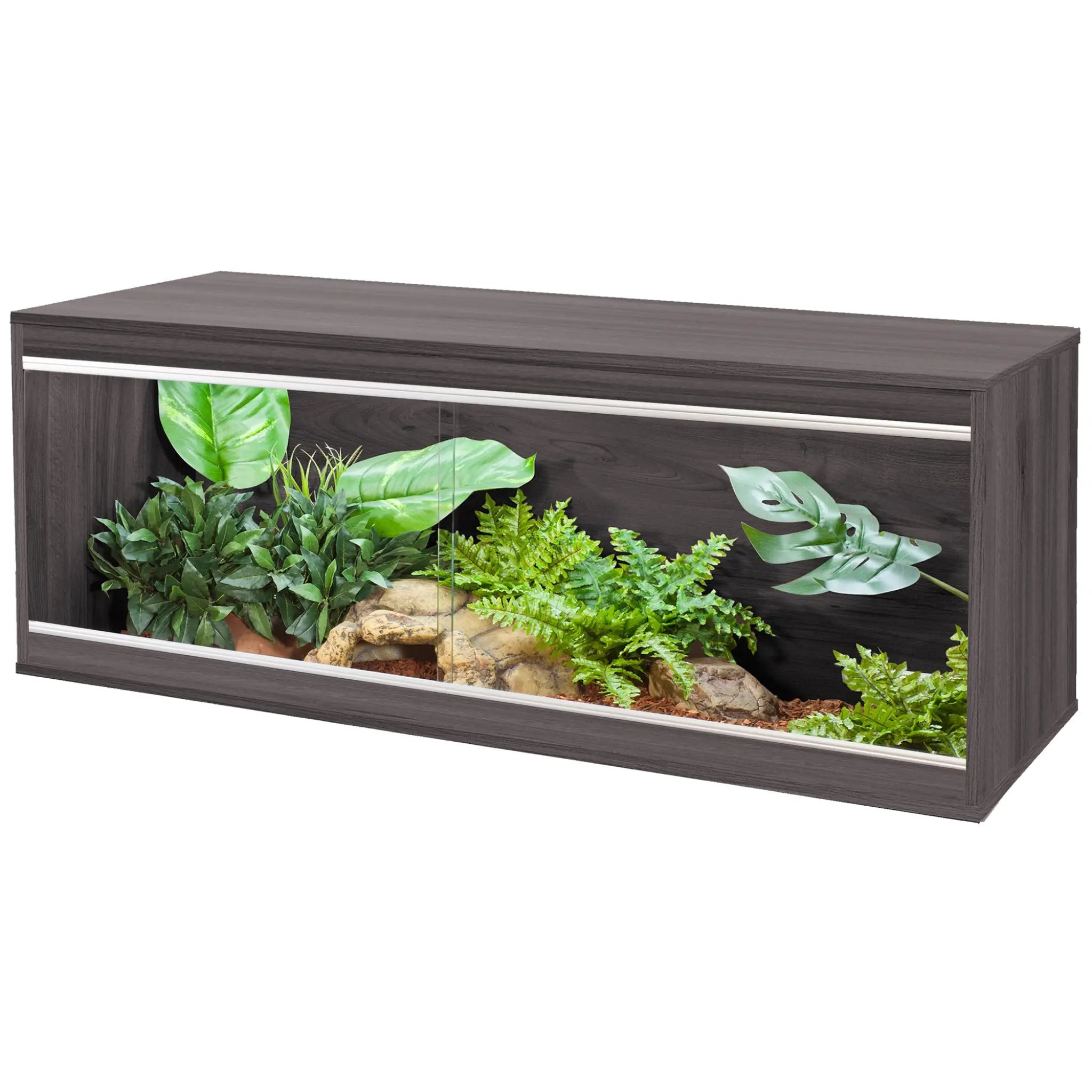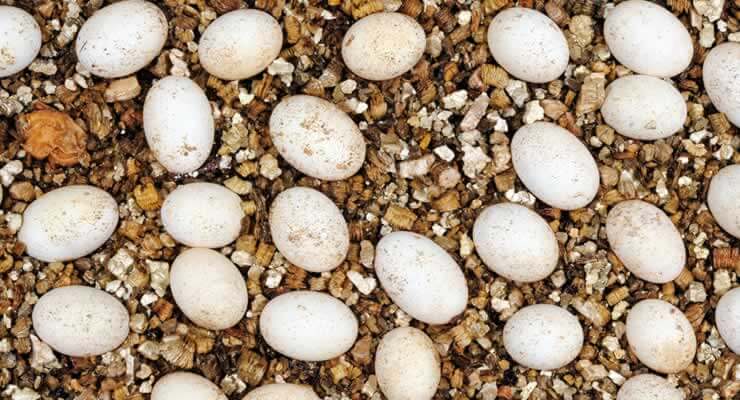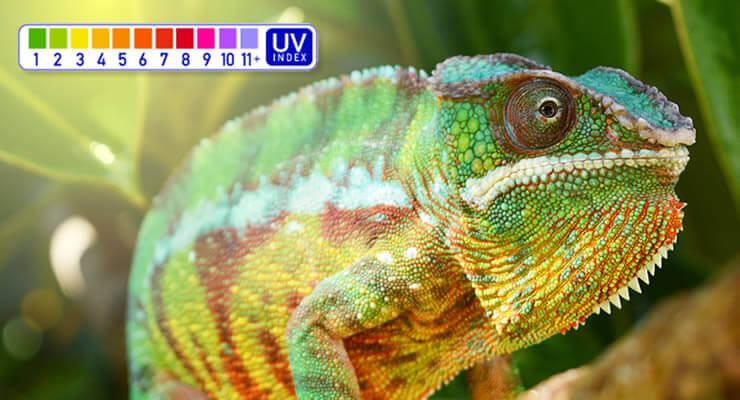
Which Ferguson Zone is My Reptile In? Your Complete Guide
by Gary Rolfe on in Guides
We know that recreating the ultraviolet part of sunlight is very important to reptile health and well-being.
But how do we measure it, with what, and how much do we need for our animals? Each species of reptile has different UV needs based on their natural habitat and basking behaviors, which is where Ferguson Zones come in.
In this guide, we'll explain how to determine your reptile’s Ferguson Zone and why getting their UV setup right is so important for their health.
The Importance of Measuring UV Light for Reptiles
Reptiles rely on ultraviolet (UV) light, particularly within the UVB range, to produce vitamin D3, which is crucial for their health.
To ensure reptiles get the UV exposure they need, a device like the Solarmeter 6.5 is essential, measuring in the 280-400nm range.
Originally developed to help people monitor UV levels to avoid sunburn, it’s equally useful for reptile owners since the measured spectrum closely aligns with the range needed for D3 synthesis.
The scale starts at 0 and goes upwards. This has been used in weather forecasting, when sunny, and is expressed as the UV Index (UVI). The higher the UVI the greater the power of the sun, which changes over the course of the day reaching its peak at midday.
Using Ferguson Zones to Tailor UV Needs for Your Reptile

As reptile keepers, we can use this index to measure wavelengths that let our reptiles produce their own vitamin D3.
As our pet reptiles originated from different countries, with many different habitats, they have morphologically evolved to take advantage of environmental niches for the optimal benefit to their species. This means that two different types of reptiles, even from the same area, may still have completely different UV requirements.
To help make sense of this, a renowned herpetologist, Dr. Gary Ferguson measured different reptile’s daily basking sites and exposure times which gave him a good indication of their natural UV requirements.
These species were divided up into four different sun exposure groups, which are now referred to as Ferguson zones. Each zone was allocated a range of figures, calculated from the readings, that were taken from the animals basking UVI. Other researchers have added more data to this study to help create a list of animals that fit into these four zones.
Find the Right Ferguson Zone for Your Reptile
Search the list below and find your reptiles to find out which Ferguson Zone they are categorised in.
If you cannot find what you are looking for, use a closely related species as a reference point or email us at sales@reptilecentre.com for advice about your specific reptile.
Ferguson Zone 1

Crepuscular or Shade Dweller
Zone range UVI 0 – 0.7 (Maximum UVI: 0.6 – 1.4 in basking zone)
- Two-horned mountain horned dragon (Acanthosaura capra)
- Rough-bellied mountain horned dragon (Acanthosaura lepidogaster)
- Red-eyed tree frog (Agalychnis callidryas)
- Lemur leaf frog (Agalychnis lemur)
- Mallorcan midwife toad (Alytes muletensis)
- Common midwife toad (Alytes obstetricans)
- Axolotl (Ambystoma mexicanum)
- Tiger salamander (Ambystoma tigrinum)
- Jamaican brown anole (Anolis lineatopus)
- Children’s python (Antaresia childreni )
- Stimson’s python (Antaresia stimsoni orientalis)
- Woma python (Aspidites ramsayi)
- Harlequin toad (Atelopus spumarius hoogmoedi)
- Oriental fire-bellied toad (Bombina orientalis )
- Yellow-bellied toad (Bombina variegata)
- Brown leaf chameleon (Brookesia superciliaris)
- Solomon island boa (Candoia carinata)
- Argentine horned frog (Ceratophrys ornata)
- Emerald tree boa (Corallus caninus)
- Amazon tree boa (Corallus hortulanus)
- Splendid leaf frog (Cruziohyla calcarifer)
- Indochinese box turtle (Cuora galbinifrons)
- Chinese fire-bellied newt (Cynops orientalis)
- Green & black poison arrow frog (Dendrobates auratus)
- Bumblebee dart frog (Dendrobates leucomelas)
- Yellow & black poison arrow frog (Dendrobates leucomelas)
- Dyeing poison arrow frog (Dendrobates tinctorius)
- Blue posion arrow frog (Dendrobates tinctorius azureus)
- Amazonian dart frog (Dendrobates ventrimaculatus)
- USA green tree frog (Dryophytes cinereus)
- Gray tree frog (Dryophytes versicolor)
- Asian spiny toad (Duttaphrynus melanostictus )
- Sambava tomato frog (Dyscophus guineti)
- Cuban boa (Epicrates angulifer)
- Leopard gecko (Eublepharis macularius)
- Green anaconda (Eunectes murinus)
- Yellow anaconda (Eunectes notaeus)
- Sardinian brook salamander (Euproctus platycephalus)
- Tokay gecko (Gecko gecko)
- Black-breasted leaf turtle (Geoemyda spengleri)
- Cave gecko (Goniurosaurus hainanensis)
- Asian house gecko (Hemidactylus frenatus)
- Spiny turtle (Heosemys spinosa)
- European green tree frog (Hyla arborea)
- African reed frog (Hyperolius viridiflavus)
- Alpine newt (Ichthyosaura alpestris)
- Colorado River toad (Incilius alvarius)
- Chubby frog (Kaloula pulchra)
- Home’s hingeback tortoise (Kinixys homeana)
- Pueblan milk snake (Lampropeltis triangulum campbelli)
- Sinaloan milk snake (Lampropeltis triangulum sinaloae)
- Stuart’s milksnake (Lampropeltis triangulum stuarti)
- Budget frog (Lepidobatrachus laevis)
- Mourning gecko (Lepidodactylus lugubris)
- White-lipped tree frog (Litoria infrafrenata)
- Brown mantella (Mantella betsileo)
- Bronze mantella (Mantella crocea)
- Blue leg mantella (Mantella expectata)
- Long-nosed horned frog (Megophrys nasuta)
- Amethystine python (Morelia amethistina)
- Green tree python (Morelia viridis)
- Lesser night gecko (Nactus coindemirensis)
- Common mudpuppy (Necturus maculosus)
- Kaiser’s newt (Neurergus kaiseri)
- Northern velvet gecko (Oeudura castelnaui)
- Banded newt (Ommatotriton vittatus)
- Rough green snake (Opheodrys aestivus)
- Hundred flower snake (Orthriophis moellendorffi )
- Corn snake (Pantherophis guttatus guttatus)
- Madagascan ground gecko (Paroedura pictus)
- Black-legged dart frog (Phyllobates bicolor)
- Golfodulcean poison frog (Phyllobates vittatus)
- Sharp ribbed newt (Pleurodeles waltl)
- Borneo long-eared frog (Polypedates otilophus )
- Fan-footed gecko (Ptyodactylus hasselquistii)
- Reticulated python (Python (Broghammerus) reticulatus)
- Borneo short-tailed python (Python brietensteini)
- Blood python (Python curtus)
- Burmese python (Python molurus bivittatus)
- African bullfrog (Pyxicephalus adspersus)
- Crested gecko (Rhacodactylus ciliatus)
- Fire salamander (Salamandra salamandra)
- Madagascan tree boa (Sanzinia madagascarensis)
- Madagascan burrowing frog (Scaphiophryne marmorata)
- Eastern spadefoot toad (Scaphiopus holbrookii)
- Sandfish (Scincus scincus)
- Elegant gecko (Stenodactylus sthenodactylus)
- White-spotted gecko (Tarentola annularis)
- Viper gecko (Teratolepis fasciata)
- Vietnamese mossy frog (Theloderma corticale)
- Bug-eyed tree frog (Theloderma stellatum)
- Black-spotted casque headed treefrog (Trachycephalus nigromaculatus)
- Red-eyed crocodile skink (Tribolonotus gracilis)
- Marbled newt (Triturus marmoratus)
- Himalayan newt (Tylototriton verrucosus)
- Caecilian worm (Typhlonectes spp.)
- Henkel’s leaf-tail gecko (Uroplatus henkeli)
- Satanic leaf-tailed gecko (Uroplatus phantasticus)
- African clawed frog (Xenopus laevis)
Ferguson Zone 2

Partial Sun or Occasional Basker
Zone range UVI 0.7 – 1.0 (Maximum UVI: 1.1 – 3.0 in basking zone)
- Dumerils boa (Acrantophis dumerili)
- American green anole (Anolis carolinensis)
- Jamaican blue-pants anole (Anolis grahami)
- Spotted python (Antaresia maculosa)
- Smooth softshell (Apalone mutica)
- Plumed basilisk (Basiliscus plumifrons )
- Boa constrictor (Boa constrictor)
- Hogg Island boa (Boa constrictor imperator)
- African house snake (Boaedon fuliginosus)
- Banded mangrove snake (Boiga dendrophila melanota)
- Fiji banded iguana (Brachylophus bulabula)
- Cane toad (Bufo marinus)
- Giant Hispaniolan galliwasp (Celestus warreni)
- Meller’s chameleon (Chamaeleo melleri)
- Yellow foot tortoise (Chelonoidis denticulata)
- Common snapper (Chelydra serpentina)
- Trinket snake (Coelognathus helena)
- Radiated rat snake (Coelognathus radiata)
- Prehensile or monkey-tailed skink (Corucia zebrata)
- Northern caiman lizard (Dracaena guianensis)
- Korean rat snake (Elaphe anomala)
- Bairds rat snake (Elaphe bairdi)
- King rat snake (Elaphe carinata)
- Japanese rat snake (Elaphe climacophora)
- Dione rat snake (Elaphe dione)
- Great plains rat snake (Elaphe emoryi)
- Texas rat snake (Elaphe obsoleta lindheimeri)
- Argentine rainbow boa (Epicrates Cenchria)
- Brazilian rainbow boa (Epicrates cenchria)
- Colombian rainbow boa (Epicrates maurus)
- Jamaican boa (Epicrates subflavus)
- Maranon poison frog (Excidobates mysteriosus)
- Red foot tortoise (Geochelone carbonaria)
- Kenyan sand boa (Gongylophis colubrinus)
- Bell’s forest dragon (Gonocephalus bellii)
- Red-tailed rat snake (Gonyosoma oxycephalum)
- Pink tongued skink (Hemisphaeriodon gerrardii)
- Fat-tailed gecko (Hemitheconyx caudicinctus)
- Western hognose (Heterodon nasicus nasicus)
- False water cobra (Hydrodynastes gigas)
- Elongated tortoise (Indotestudo elongata)
- Australian water dragon (Intellagama (Physignathus) lesueurii)
- Grey banded kingsnake (Lampropeltis alterna)
- Mexican milksnake (Lampropeltis annulata)
- Prairie kingsnake (Lampropeltis calligaster)
- Brooks kingsnake (Lampropeltis getula brooksi)
- Californian kingsnake (Lampropeltis getula californiae)
- Florida kingsnake (Lampropeltis getula floridana)
- Goins kingsnake (Lampropeltis getula meansi)
- Mexican black kingsnake (Lampropeltis getula nigrita)
- Desert kingsnake (Lampropeltis splendida)
- Honduran milk snake (Lampropeltis triangulum hondurensis)
- Nelson’s milk snake (Lampropeltis triangulum nelsoni)
- Fire skink (Lepidothyris (Riopa) fernandi)
- Savu python (Liasis macklotti savuensis)
- Olive python (Liasis olivaceus)
- Green-eyed frog (Lithobates vibicarius)
- Electric blue day gecko (Lygodactylus williamsi)
- Pancake tortoise (Malacochersus tornieri)
- Golden mantella (Mantella aurantiaca)
- Green mantella frog (Mantella viridis)
- Boelens python (Morelia boeleni)
- Bredl’s python (Morelia bredli )
- Carpet python (Morelia spilota)
- Scheltopusik (Ophisaurus apodus)
- Bamboo rat snake (Oreocryptophis porphyraceus)
- Taiwan beauty snake (Orthriophis taeniurus)
- Everglades rat snake (Pantherophis alleghaniensis)
- Grey rat snake (Pantherophis spiloides)
- White’s tree frog (Pelodryas caerulea)
- Golden poison frog (Phyllobates terribilis)
- Waxy monkey tree frog (Phyllomedusa sauvagii)
- Asian water dragon (Physignathus cocincinus)
- Gopher snake (Pituophis catenifer)
- Bullsnake (Pituophis catenifer sayi)
- Five-lined skink (Plestiodon fasciatus)
- Golden tree frog (Polypedates leucomystax)
- Royal python (Python regius)
- African rock python (Python sebae)
- Pasco poison frog (Ranitomeya lamasi)
- Gargoyle gecko (Rhacodactylus auriculatus)
- New Caledonian giant gecko (Rhacodactylus leachianus)
- Painted wood turtle (Rhinoclemmys pulcherrima)
- Rhino rat snake (Rhyncophis boulengeri)
- Razorback musk turtle (Sternotherus carinatus)
- Common musk turtle (Sternotherus odoratus)
- Moorish gecko (Tarentola mauritanica)
- Eastern box turtle (Terapene carolina)
- Ornate box turtle (Terapene ornata)
- Wonder gecko (Teratoscincus scincus)
- Mexican garter snake (Thamnophis eques)
- Chequered garter snake (Thamnophis marcianus)
- San Francisco garter snake (Thamnophis sirtalis tetrataenia)
- Southern or blotched blue-tongued lizard (Tiliqua nigrolutea)
- Shingleback lizard (Tiliqua rugosa)
- Eastern blue-tongued lizard (Tiliqua scincoides)
- Jackson’s chameleon (Trioceros jacksonii)
- Four-horned chameleon (Trioceros quadricornis)
- Rio Cauca caecilian (Typhlonectes natans)
- Tricolor hognose (Xenodon pulcher)
- Leopard snake (Zamenis situla)
Ferguson Zone 3

Partial or Open Sun Baskers
Zone range UVI 1.0 – 2.6 (Maximum UVI: 2.9 – 7.4 in basking zone)
- Black-eyed tree frog (Agalychnis moreletii)
- Horsfield’s tortoise (Agrionemys horsfieldii)
- Cuban knight anole (Anolis equestris)
- Cuban brown anole (Anolis sagrei)
- Black-headed python (Aspidites melanocephalus)
- Radiated tortoise (Astrochelys radiata)
- Ploughshare tortoise (Astrochelys yniphora)
- Bornean bloodsucker/green crested lizard (Bronchocela cristatella)
- Oriental garden lizard, eastern garden lizard, bloodsucker (Calotes versicolor)
- Parson’s chameleon (Calumma parsonii)
- African spurred tortoise (Centrochelys sulcata)
- Yemen chameleon (Chamaeleo calyptratus)
- Broad- shelled turtle (Chelodina expansa)
- Common or eastern snake-necked turtle (Chelodina longicollis)
- Frilled dragon (Chlamydosaurus kingii)
- Spotted turtle (Clemmys guttata)
- Collared lizard (Crotaphytus collaris)
- Painted turtle (Crysemys picta ssp.)
- Central netted dragon (Ctenophorus nuchalis)
- Guatemalan black iguana (Ctenosaura palearis)
- Cayman Brac iguana (Cyclura nubila caymanensis)
- Grand cayman iguana/ blue iguana (Cyclura nubila lewisi)
- Desert iguana (Dipsosaurus dorsalis)
- Cunningham’s rock skink (Egernia cunninghami)
- Murray short-necked turtle (Emydura macquarii)
- European pond turtle (Emys orbicularis)
- Berber skink (Eumeces schneideri)
- Carpet chameleon (Furcifer lateralis)
- Panther chameleon (Furcifer pardalis)
- Giant spiny chameleon (Furcifer verrucosus)
- Indian star tortoise (Geochelone elegans)
- Aldabra tortoise (Geochelone gigantea)
- Leopard tortoise (Geochelone pardalis)
- Sudan plated lizard (Gerrhosaurus major)
- Ornate plated lizard (Gerrhosaurus validus)
- Ouachita map turtle (Graptemys ouachitensis)
- False map turtle (Graptemys pseudogeographica)
- Green iguana (Iguana iguana)
- Red iguana (Iguana iguana)
- Bell’s hingeback tortoise (Kinixys belliana)
- Speke’s hingeback tortoise (Kinixys spekii)
- Sand lizard (Lacerta agilis)
- Curly tail lizard (Leiocephalus carinatus)
- Striped water dragon (Lophognathus temporalis)
- Dimond back terrapin (Malaclemys terrapin)
- Mediterranean pond turtle (Mauremys leprosa)
- Reeve’s turtle (Mauremys reevesii)
- Eurasian pond turtle (Mauremys rivulata)
- Dimond python (Morelia spilota spilota)
- Borneo tree toad (Pedostibes hosii)
- African helmeted turtle (Pelomedusa subrufa)
- Yellow-headed day gecko (Phelsuma klemmeri)
- Gold dust day gecko (Phelsuma laticauda)
- Giant day gecko (Phelsuma madagascariensis grandis)
- Standing’s day gecko (Phelsuma standingi)
- Side-neck turtle (Phrynops geoffranus)
- Rankins dragon (Pogona henrylawsoni)
- Bearded dragon (Pogona vitticeps)
- Cooters (Pseudemys concina ssp.)
- River cooter (Pseudemys concinna)
- Florida red-bellied cooter (Pseudemys nelsoni)
- Red-bellied cooter (Pseudemys rubriventris)
- Blue tegu (Salvator merianae )
- Eastern fence lizard (Sceloporus consobrinus )
- Blue spiny swift (Sceloporus cyanogenys)
- Texas spiny lizard (Sceloporus olivaceus)
- Cook strait tuatara (Sphenodon punctatus)
- Asian long-tailed lizard (Takydromus sexlineatus)
- Greek spur-thighed tortoise (Testudo graeca)
- Hermann’s tortoise (Testudo hermanni)
- Egyptian tortoise (Testudo kleinmanni)
- Eyed lizard (Timon lepidus)
- Hispaniolan elegant slider (Trachemys decorata)
- Red-eared slider (Trachemys scripta elegans)
- Yellow-bellied slider (Trachemys scripta scripta)
- Amazon milk frog (Trachycephalus resinifictrix)
- Von Hohnel’s chameleon (Trioceros hoehnelli)
- Black and white tegu (Tupinambis merianae)
- Red tegu (Tupinambis rufescens)
- Golden tegu (Tupinambis teguixin)
- Desert side-blotched lizard (Uta stansburiana stejnegeri)
- Ackie monitor (Varanus acanthurus)
- Black tree monitor (Varanus beccarii)
- Philippine water monitor (Varanus cumingi)
- Kimberley rock monitor (Varanus glauerti)
- Blue tree monitor (Varanus macraei)
- Nile monitor (Varanus niloticus)
- Argus monitor (Varanus panoptes)
- Emerald tree monitor (Varanus prasinus)
- Roughneck monitor (Varanus rudicollis)
- Spencer’s goanna (Varanus spenceri)
- Timor monitor (Varanus timorensis)
- Lace monitor (Varanus varius)
Ferguson Zone 4

Mid-day Sun Basker
Zone range UVI 2.6 – 3.5 (Maximum UVI: 4.5 – 9.5 in basking zone)
- Red-headed agama (Agama agama)
- Spiderman agama (Agama mwanzae)
- Utila iguana (Ctenosaura bakeri)
- Rhino iguana (Cyclura cornuta cornuta)
- Cuban rock iguana (Cyclura nubila)
- Galapagos tortoise (Geochelone nigra)
- Lesser earless lizard (Holbrookia maculata)
- Lesser Antillean iguana (Iguana delicatissima)
- Serrated casque-headed iguana (Laemanctus serratus)
- Starred agama (Laudakia stellio brachydactyla)
- Butterfly agama (Leiolepis belliana)
- Round Island skink (Leiolopisma telfairi)
- Desert horned lizard (Phrynosoma cornutum)
- Chuckwalla (Sauromalus ater)
- Angel island chuckwalla (Sauromalus hispidus)
- Sagebrush lizard (Sceloporus graciosus)
- Blue spiny lizard (Sceloporus serrifer cyanogenys)
- Sungazer (Smaug giganteus)
- Marginated tortoise (Testudo marginata)
- Moroccan uromastyx (Uromastyx acanthinura)
- Egyptian uromastyx (Uromastyx aegyptia)
- Saharan uromastyx (Uromastyx geyri)
- Ocellated uromastyx (Uromastyx ocellatus)
- Ornate uromastyx (Uromastyx ornata)
- Bosc monitor (Varanus exanthematicus)
- Beaver tailed agama (Xenagama batillifera)
Need Help Understanding Ferguson Zones?
Do not hesitate to get in touch with us at Northampton Reptile Centre if you need any help understanding your reptile’s UVB lighting requirements!
Email us at sales@reptilecentre.com or feel free to email Reptile Systems who manufacture some of the finest UVB bulbs on the market. Their email address is support@aquariumsystems.uk.


